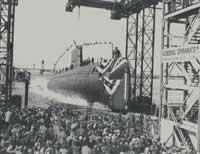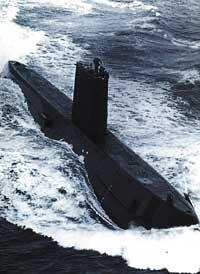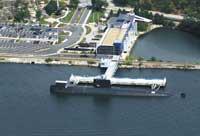Nautilus, the king under the sea

When he first immersed himself in the water in 1952, he was undoubtedly the king of the submarines. It was larger than the other submarines and had much more autonomy. Náutilus achieved this superiority thanks to the nuclear reactors, which was the first nuclear submarine.
Today, simple listening to the nuclear term causes chills, since listening to nuclear energy evokes the dangers of nuclear waste.
The risk, the nuclear energy, especially in the arms industry, was a great advance.
As for nuclear vehicles, the submarines were the pioneers. When they built Nautilus, the submarines had Diesel engines for propulsion. However, their difficulties to keep under water were remarkable, since Diesel engines need oxygen for combustion and can carry a limited amount of oxygen, so when the engine is exhausted it stops and can not continue filling the batteries. This forced to climb to the surface to launch engines often and fill the batteries.
However, Nautilus' nuclear reactor did not need oxygen, which allowed him to stay for a long time without increasing the surface.
As for autonomy, he also broke records, since Nautilus only needed a piece of uranium the size of a ball to make one hundred thousand nautical miles, about 160 thousand kilometers. Thanks to this, I did not have to dock so frequently in search of fuel.
According to the chronicles of the time, the time that could remain under water was unlimited, but the real limit was put by the crew: it would not be easy to spend days and days for 116 people who accumulated inside the submarine without seeing the sunlight.
One of the longest trips in Nautilus was in 1958. He left Honolulu and did not stop until he reached the pier of Portland, in England. During this long journey he crossed the ice layer of the Archticus in 95 hours, inevitably in the seabed. On that trip it became the first submarine that reached the North Pole.
Giant submarine submarine
That first nuclear submarine clearly showed that it was possible to make submarines of the size of the ships. In fact, its length was almost one hundred meters and its weight was three thousand tons.
However, despite its large size it was not slow, but thanks to the nuclear propulsion a speed of 20 knots could be reached, almost 40 km/h. It left behind the fastest submarines of the time.

The American rival not only feared the size and speed of the nuclear submarine.
Nautilus was very well equipped for the war: he had six torpedo shooters and could throw 24 torpedo.
Faced with the success of USS Nautilus (SSN 571), the U.S. military built more nuclear submarines called Nautilus. The rest of vehicles and nuclear devices arrived later, such as ships, planes, satellites...
All vehicles driven by nuclear propulsion have the same basic system. The moving reactor is very similar to that of nuclear power plants, being smaller.
Nautilus separated two water circuits. The fission of Uranium-235 heated a water circuit that in turn heated the other water circuit. In this second water circuit had a turbine that is dragged by the water vapor. This steam turbine put in operation the generators and propellants of underwater electricity.
As has been said, both water circuits were separated, which allowed to avoid the exit of radioactive substances outside the submarine. In fact, in the first circuit the radioactive isotopes produced in the fission of uranium were accumulated.
Ancient nautilus

Due to radioactive waste, Nautilus had no problems until its withdrawal. But nuclear submarines, in general, have poured numerous wastes into the sea, mainly due to the breakdowns produced in accidents.
There are hundreds of nuclear submarines that cover all the seas of the world and this type of submarines give much work before or after. When they are old, repairs are becoming more frequent and, inevitably, when they are removed, radioactive waste stored inside must be treated.
Nautilus made his last trip in 1980. He was moved to land and after five years of work he became a museum, eliminating nuclear waste and after some changes. It is currently located in the American city of Groton, in the Nautilus Museum.





